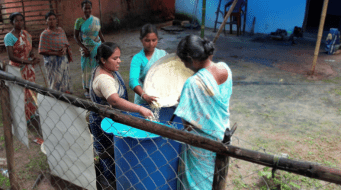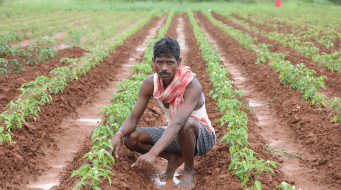-Mandar Sathe
There is Hiware Bazar – a village of 60 millionaires. Also, there is Ralegan Siddhi – A model village renowned for sustainable development of its water resources. I am sure there are certainly a few more examples, although not as famous as aforementioned. The question now arises is that – In a state of more than 45000 villages, why only few villages succeed in developing their villages through integrated water resource management?
There ain’t a single answer to the above question. However, a consensus amongst researchers and practitioners underline the importance of effective and collective local water governance for sustainable water management. There are two important factors which may derail the process of collective water governance. These factors are:
- Traditionally, ownership of groundwater is associated with the ownership of land. Through the easement Act, the landowner gets the right to extract groundwater under the respective piece of land.
- Bore well drilling technology coupled with high capacity submersible pump sets has made easy access to even deeper aquifers.
These two factors form a strong coalition. Traditionally many individuals have fetched huge benefits from exploitation of groundwater. If a soil – water conservation program is implemented, and if there is an increased availability of groundwater in their region, they would start exploiting the groundwater resources. There is often no adequate motivation to manage the available water collectively and to share the benefits of soil – water conservation programs equitably.
Villages like Hivare Bazar and Ralegan Siddhi could overcome the barriers posed by the reasons mentioned above mainly because of the strong local leadership. Anna Hazare at Ralegan Siddhi and Popatrao Pawar at Hivare Bazar could orient the synergies of the villagers to work towards a common cause. Also, villages such as Darewadi in Ahmednagar district have benefitted from prolonged engagement of NGOs such as WOTR. However, not all the villages are fortunate enough to groom local leadership or to collaborate with credible NGOs for prolonged duration. It is thus, difficult to cultivate the culture of collective local water governance. This highlights two distinct but related problems:
- For villages – it is unequitable distribution of natural resource base resulting in low level of willingness or motivation for collective water governance. This often results in inefficiencies in the soil-water conservation treatments and groundwater being exploited by a few at the expense of many farmers.
- For the agencies that run the projects – it is unsustainable projects with short lived benefits resulting in ineffective utilization of funds and non-accrual of benefits desired.
In short, villages need incentives for collective water management and resource agencies need assurance of sustainable utilization of funds.
Watershed Organisation Trust with support from Hindustan Unilever Foundation has attempted to bridge this gap by developing the “Water Governance Standard and Certification System”. Water governance standard is a set of predefined criteria that puts forward good governance practices, relevant for local water governance in agrarian communities. Certification system further provides assurance of adherence to the standard. Hence, it can be useful in providing important decision support to resource agencies in important investment decisions in developmental projects in rural areas.
Now, there are several sustainability standards, existing internationally, which are related to different aspects of water. For example, there are ISO standards for environmental considerations and water footprint, Alliance for water stewardship and European water partnership for water stewardship standards, several other sustainability standards addressing the field level sustainability requirements. Even if with different primary objectives, almost all these standards aim towards improving site-specific water governance. So is there any need for a new standard and certification system? The answer is yes. The system developed by WOTR differs from the existing sustainability standards in several ways. To begin with, the international standards are based on the basic theme of environmental and ecological concerns. WOTR’s standard is developed to address basic life and livelihood concerns of the agrarian communities. Further, the entities who adopt the existing international standards include big corporate groups, big farmers, farmer groups who are the suppliers of retail chains, and companies in food processing industry. Target group for the WOTR’s system are the agrarian communities with –a large number of small holder farmers, where it is urgent need to set an implementable governance mechanisms, and to build capacities and confidence to manage the water locally. Lastly, end audience of the WOTR’s standard is different from the existing international standards. The certified agencies operate in the markets where these certifications are valued, thus influencing the profitability of the business. However, there is limited scope for the water governance certifications to succeed in Indian markets in near future, as product price is the most important factor when it comes to the common consumers.

The Water Governance Standard and Certification System is developed to bridge the gap between agrarian communities and the resource agencies. It serves multiple objectives. Its ultimate aim is to develop a system that incentivizes agrarian communities to adopt sustainable water governance practices at local level for assured drinking water and enhanced livelihood opportunities. It thus, provides a framework and standard that:
- Helps objectively assess the level and quality of water governance at the local level
- Provides a Benchmark that incentivizes communities to define reachable water-related goals; work to realize them and track progress of implementation
- Serves as a decision guideline/ criteria for funding (public / private) to develop and stabilize water resources and infrastructure; and
- Creates a framework for incentivizing competitive bidding for water-related financing and resource acquisition.
Thus, WOTR’s standard and certification system is designed to act as a link between the agrarian communities and the resource agencies such as government departments and non-government funding agencies. On one hand, the system presents an opportunity to the communities to demonstrate their capacities to govern locally and on the other hand, it provides the resource agencies with the decision handles about allocation decisions.
There are multiple ways in which the standard and certification systems can be put to use. Some of them are listed below:
- Inclusion into Flagship Programs: Annual certification can be a mandatory condition for participation and continuation in funded schemes such as Jalyukt shiwar, Jalswaraj , Adarsh Gram Yojana, etc, as it delivers value for money and enhances sustainability.
- Competition based initiatives and Awards: Water Governance Certification can be a key criteria for determining winning applications/ nominations.
- Government / Public Sector: Annual certification can identify eligible villages or preferential candidates for availing related government schemes.
- Companies under Corporate Social Responsibility (CSR): Supporting communities for implementation of the Water Governance Standard (WGS) and certification will enhance sustainability of investments made.
To sum up, water governance standard and certification system is an initiative that provides for a system to incentivise the rural communities to manage their own water resources sustainably, equitably, and in participative manner. It is designed to simultaneously provide an objective decision support mechanism for resource organisations to make sustainable investments in their development initiatives.






1 thought on “A Case for Water Governance Standard and Certification System In Rural Areas”
Truly said
Apart from these the first requirement is to sensitize the community regarding water resource management at the local level.